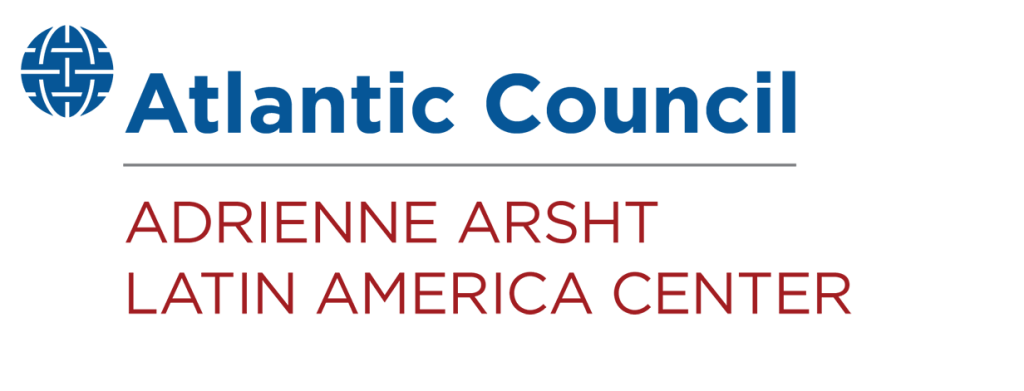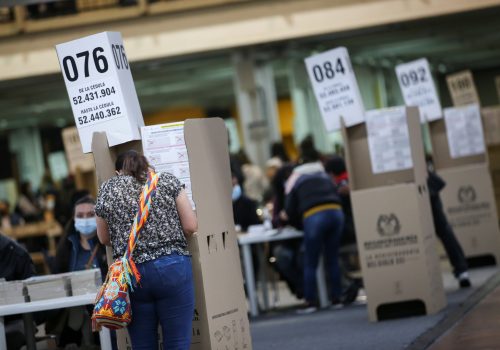June 1, 2022
Advance democracy, security and rule of law
I was deputy assistant secretary of state for South America and the Caribbean in 1999 when the administration of President William J. Clinton first contemplated a dramatic increase in support for the Colombian government. We were worried about Colombia, and the worry was bipartisan. In close-hold meetings and briefings, we debated whether the Revolutionary Armed Forces of Colombia (FARC) might actually win its then 35-year conflict with the government; whether drug traffickers might penetrate and dominate entire sectors of the government; whether one of the hemisphere’s steadiest, most reliable economies might collapse. In the offices and halls of official Washington, there was an uncharacteristic consensus that what happened in Colombia was important to the United States and that we needed a new strategy to address it.
We were relieved to find that the Colombian government of President Andrés Pastrana had reached the same basic conclusions. Government officials described three immediate crises—security, law enforcement, and economic—threatening the Colombian state. Our two governments began the serious work of hammering out a strategic approach and support package, making quick progress. Official teams moved back and forth from Washington and Bogotá for months outlining a new strategy known as “Plan Colombia.”
We agreed on all fundamental issues, but there were questions on timing and emphasis. The Pastrana government was then engaged in a bold effort at dialogue with the FARC, creating a demilitarized zone the size of Rhode Island to encourage negotiations, which lasted until 2002. The Colombian government was careful not to endorse a strategy that undercut the dialogue process, although even then, we sensed the government’s doubts (strongly shared by us) about the FARC’s commitment to peace.
We also wrestled over a name for the new strategy. I suggested “Plan Paz, Prosperidad y Progreso,” proudly pointing to the alliteration in both languages and linkage to the themes of peace, prosperity, and progress. The Colombian government concluded that since the strategic objective was to reestablish the constitutional government’s sovereignty over the entire nation, the simple phrase “Plan Colombia” should describe the effort.
With an agreed plan in hand, the Clinton Administration got down to the work of identifying, funding, and implementing the parts of Plan Colombia that we could support. Congress was enthusiastic, and we hoped for a supplemental appropriations bill to be passed and signed quickly. But for the first time, we faced divisions in our ranks on how to proceed. At the risk of over-simplification, the arguments were between the “hard side” and “soft side” of the US foreign assistance community. The “soft side” (the US Agency for International Development and the Departments of Commerce, Treasury, and parts of Justice) argued that the point of the exercise, and our strategic objective, was not to make Colombia a major military and law enforcement power, but rather to build democratic, economic, and social institutions to undercut the popular appeal of the guerrilla and drug trafficking organizations. The “hard side” (the Department of Defense, the Central Intelligence Agency, and law enforcement) argued that democracy, economic, and social development programs could not succeed if the government did not provide basic security in the communities most in need.
In the end, we decided to sequence the support. In the early years of Plan Colombia, our support would prioritize security, police, and prosecutor equipment, training, and construction. In later years, as the government re-established police and security presence throughout the country, the priority would shift to democratic institutions and social and economic development.
The rest, as they say, is history.
In January 2000, Congress overwhelmingly passed a $1 billion emergency supplemental appropriation to support Plan Colombia. For the next six years, US support for Colombia averaged nearly $1 billion per year. Until 2007, US “hard side” support was twice the level of the economic and social (“soft side”) assistance and provided the Colombian military and police the aviation and mobility to fight the FARC and traffickers. Communications equipment allowed them to listen in on guerrilla and criminal communications. New units were created, trained, and equipped to provide presence in lawless territory and support law enforcement anti-drug operations. Police stations were built and staffed in communities that had not seen police in years. Prosecutors more than doubled in number and entered the profession through a new national training curriculum.
Colombia’s governmental institutions were stressed in the 1990s, but they did not collapse. Once provided resources and infrastructure in the 2000s, they functioned as well as those of any government in the Western Hemisphere, if not the entire world. Colombia and the United States were partners in the truest sense. The two governments worked seamlessly together in sensitive programs and operations in a way rarely seen outside NATO. Cooperation produced the Jaque hostage rescue operation of 2008, dozens of drug kingpins were captured and tried, major FARC commanders were removed from the chessboard, and thousands of tons of cocaine were eliminated from the market.
Yet, each side stayed in its lanes. The armed forces received training and equipment, insisting that only they would conduct operations in Colombia; after the first two years, they were no longer taking much direct training from US counterparts. The National Police welcomed training, equipment, and intelligence, but the operations were theirs alone. Colombian prosecutors cooperated with US Justice Department counterparts, and many Colombian cases resulted in extradition, but Colombian prosecutors tried Colombian cases in Colombia.
By the time I arrived in Bogotá as ambassador, the improved security picture could be measured in statistics. President Álvaro Uribe liked to tell visitors that when he took office in 2002, more than two hundred municipalities did not have mayors in residence because of security threats; by his second term in 2006, all mayors were residential. Cocaine production began a steady decline in 2007. By 2008, the FARC had lost roughly 50 percent of its active numbers, most voluntarily surrendering. Curfews were lifted through most of the country. Construction cranes were ubiquitous in all the main cities, evidence of a building boom. By 2008, more Colombians were returning to their nation than fleeing it. And in an easily measurable statistic—the cruise line industry returned to the port of Cartagena, starting from zero in 2007, two in 2008, forty in 2009, and reaching 200 a year before the COVID-19 pandemic.
By 2005, the two governments were criticized for Plan Colombia’s continued tilt toward security and law enforcement. In truth, when the Clinton Administration first presented the case for Plan Colombia to the Congress, we had suggested (assured) that in five years, the hard/soft ratio would flip to a greater emphasis on economic and social development and democratic institutions. Whether due to the extraordinary success of hard-side programs or the bureaucratic tendency to keep doing what we did the year before, the ratios had not flipped. The critics had a valid argument.
The 2006 midterm US elections returned Congress to Democrat control, and by 2008, the majority of US assistance to Plan Colombia was focused on the “soft side.” It happened so quickly that the embassy’s USAID Mission suffered financial whiplash on seeing its budget triple overnight.
The timing of the imposed shift in emphasis was fortuitous. After seven years of Plan Colombia, the armed forces and law enforcement were highly professionalized. They were, in fact, the best military and police institutions in all of Latin America. By establishing security and law enforcement presence throughout the country, it was possible for Colombia’s political, economic, and social institutions to do their jobs. Had we tried to implement the labor-intensive development programs in poor communities with the security conditions of 2000, we would have failed.
In Colombia, as in the United States, the security/military and civilian communities do not always see eye to eye. But after seven years of pounding against the guerrillas and traffickers, the armed forces and police understood that civilian success in their mission was their ticket to success. The civilians understood, for their part, that if they wanted to build roads, clinics, electrical grids, clean water, schools, and community centers, if they wanted to bring sustainable development to poor campesinos and city barrios, they needed the support of the police and military.
To paraphrase Uribe, our support program shifted from “democratic security” to “secure democracy,” from a security program with strong democracy components to a democracy program with robust security elements. In my final two years in Colombia, the US embassy supported agricultural programs providing poor campesinos the opportunity to grow coffee, cacao, or African palm rather than coca. We built rural roads with parallel electric, water, and sewer lines to allow farmers to get their crops to market. We constructed and opened more than fifty “Justice Houses” in which poor Colombians could find justice, social, and medical help in a single day. We supported prominent development plans in areas previously controlled by the FARC, signaling that the government of Colombia was back to stay.
In 2016, six years after my tenure as ambassador had ended, I returned to Cartagena, Colombia, when President Juan Manuel Santos signed the peace accord with the FARC. Colombians will argue for generations about the agreement and the process leading to it. But most will agree the democracy and security support for Plan Colombia got the accord over the goal line.
No essay on US support for democracy and security in Colombia is complete without some lessons learned. Here are a few:
- Security and democracy are tightly connected. You cannot have one without the other.
- A long-term security and development plan must be adaptable. Assumptions will prove wrong. Reality will change on the ground. The plan, the planners, and the implementers must be able to change over time.
- No nation-building plan succeeds without buy-in and commitment from the host government. We cannot want success more than they do. During my ambassadorship, we calculated that the Colombian government put $30 into Plan Colombia for every US dollar.
- Plan Colombia did not succeed because of the work of US government officials and contractors; it succeeded because of the work of Colombian officials and citizens implementing joint programs.
- It takes time and patience to build bipartisan support for a major foreign assistance program and even more to maintain it. But it is worth the effort.
Some academics argue that Plan Colombia is the most successful nation-building exercise since the Marshall Plan in 1947. They might just be right.
* * *
Ambassador William (Bill) Brownfield is a career ambassador in the United States Foreign Service and the former assistant secretary of state for the bureau of international narcotics and law enforcement affairs as of January 10, 2011. He has previously served as U.S. Ambassador to Chile, Venezuela, and Colombia.
Related Allies essays
A roadmap for a new type of engagement
This moment opens the door for a reimagined US partnership with Colombia based on a shared vision for a more prosperous, inclusive, and sustainable future.
Related program

The Adrienne Arsht Latin America Center broadens understanding of regional transformations and delivers constructive, results-oriented solutions to inform how the public and private sectors can advance hemispheric prosperity.
Image: The colors of the Colombian flag are reflected in a canal next to the convention center in Cartagena, Colombia, September 26, 2016. REUTERS/Jaime Saldarriaga



